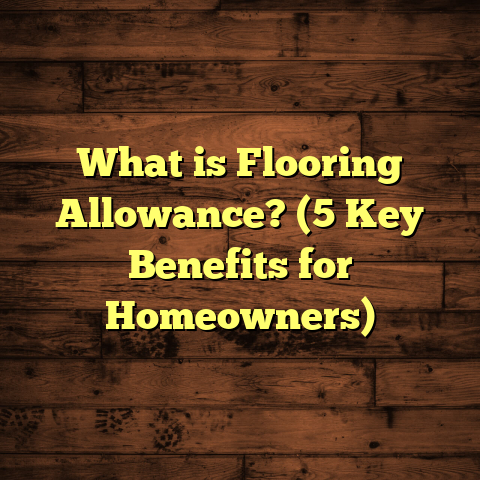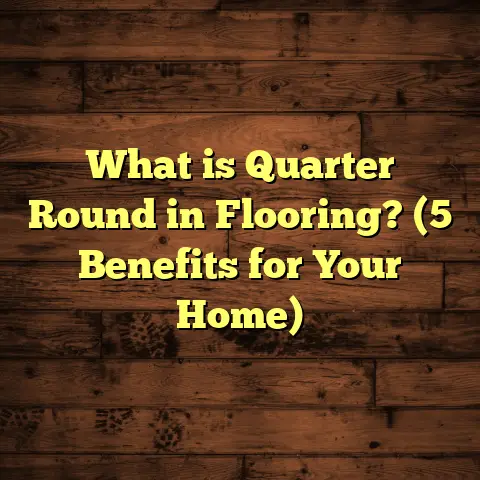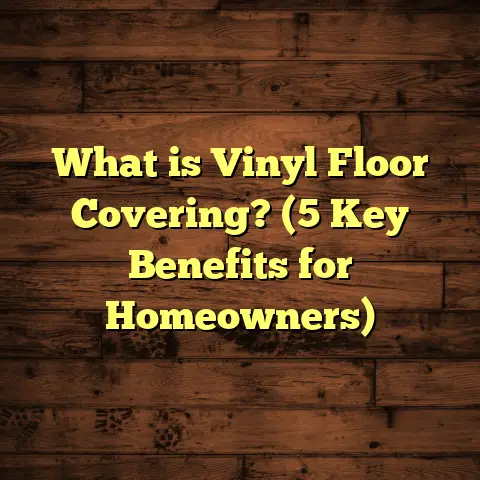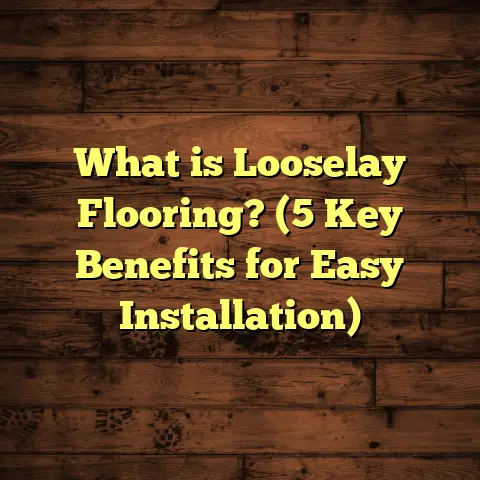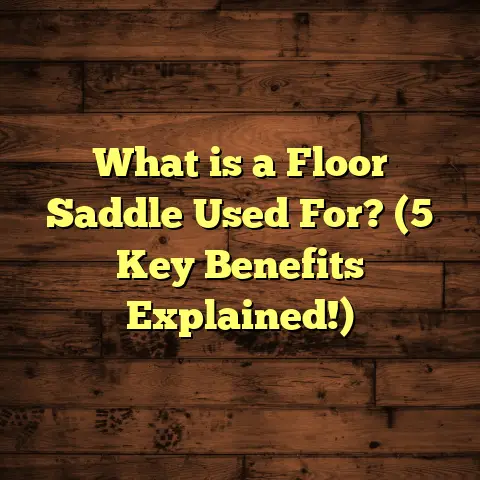What is LVP Flooring? (5 Reasons It’s Your Best Home Upgrade)
When I think about what makes a home truly unique, I often come back to the little details
that reflect personality and lifestyle.
Flooring is one of those details.
It’s the foundation you
walk on every day, but it can also be a statement piece that ties your entire space together.
Among the many options out there, I’ve found myself recommending LVP flooring again and
again—not just because it looks great, but because it offers so many practical benefits that
few other materials can match.
If you’re curious about why LVP is showing up everywhere—from trendy new builds to cozy
renovations—stick with me.
I’ll walk you through what LVP flooring really is, why it’s become
my go-to recommendation, and some honest thoughts on both its strengths and the few things
you need to watch out for.
What Is LVP Flooring?
Let me start by answering the question that probably brought you here in the first place: what
is LVP flooring?
The term stands for Luxury Vinyl Plank.
At its core, it’s a type of vinyl floor
designed to look like traditional hardwood planks.
But unlike laminate or basic vinyl sheets,
LVP uses advanced layers and printing technology to mimic wood grain, textures, and even
imperfections that make real wood so appealing.
The construction of LVP typically involves several layers:
- Wear Layer: This is the top coating that protects your floor from scratches, dents, and stains.
- Design Layer: Under the wear layer is a high-resolution photographic layer that gives the plank its wood look.
- Core Layer: Usually made of vinyl or composite materials, this provides stability and waterproofing.
- Backing Layer: The bottom layer adds support and sometimes cushioning.
The thickness of each layer can vary, influencing durability and feel underfoot.
The wear layer is measured in mils (one-thousandth of an inch), and for homes with pets or kids, I usually suggest going for a wear layer of 12 mils or higher.
What’s cool is that some LVP planks come with added features like embossing (texture you can feel), beveled edges for a realistic plank separation look, or even enhanced soundproofing.
How Does LVP Compare to Other Flooring?
I’ve worked with hardwood, laminate, tile, and carpet over the years.
Each has its perks but also limitations.
Hardwood floors are beautiful but require regular maintenance and are vulnerable to water damage.
Laminate can look good but often lacks moisture resistance and can chip easily.
Tile is durable but cold and hard underfoot.
LVP strikes a balance between these extremes.
It offers the aesthetic appeal of hardwood without the maintenance headaches or fragility.
Plus, it’s softer and warmer than tile and easier to clean than carpet.
My First Experience With LVP Flooring
When I first installed LVP in my own home about five years ago, I was coming off a long stretch of dealing with hardwood floors that just didn’t hold up well around my energetic kids and our dog.
Hardwood scratches easily, dents from dropped toys, and water from spills would stain or warp the wood.
I wanted something that looked just as good but handled everyday life better.
I picked an LVP product with a textured oak finish and a 12 mil wear layer.
The installation was quicker than I expected—I did a floating click-lock install over our existing subfloor without tearing out the old floor.
After several years of heavy use—kids running around, spilled drinks, muddy paws—the floor still looks fantastic.
No visible scratches or swelling from occasional water spills.
That personal experience turned me into an advocate for LVP flooring because it met my practical needs without sacrificing style.
5 Reasons LVP Flooring Could Be Your Best Home Upgrade
1. Durability That Can Handle Real Life
If you have kids or pets—or just lots of foot traffic—you know how quickly floors can take a beating.
I’ve recommended hardwood to families who then call me back after a year complaining about scratches or stains.
LVP’s multi-layer design gives it serious durability advantages.
The top wear layer protects against scratches from furniture or pet claws and resists stains from common household spills.
One client I worked with has three young children who love arts and crafts (which means paint everywhere).
Their LVP kitchen floor still looks spotless after multiple accidental spills of paint, juice, and even markers.
The wear layer thickness matters here:
- 6 mil: Suitable for light residential use (bedrooms, guest rooms)
- 12 mil: Good for most residential spaces with moderate traffic
- 20 mil+: Commercial-grade durability for heavy foot traffic or industrial settings
According to research by the Resilient Floor Covering Institute (RFCI), LVP shows over 50% better scratch resistance compared to laminate flooring.
It also performs well against scuffs from shoes or rolling chairs.
2. Water Resistance That Saves You Stress
I can’t tell you how many times I’ve seen hardwood floors ruined by water damage—whether from leaky pipes, spills, or humidity.
LVP is mostly waterproof because it’s made of vinyl materials that don’t absorb moisture.
This means it doesn’t swell, warp, or buckle like hardwood or laminate when exposed to water.
I personally chose LVP for my basement remodel because basements tend to have moisture issues.
Having a floor that can handle occasional dampness without damage gave me peace of mind.
Some brands even offer “waterproof” warranties now.
In tests, LVP planks have stood up to standing water for hours without warping or discoloration.
If you’re thinking about flooring for kitchens, bathrooms, laundry rooms, or basements—areas where moisture is common—LVP is one of the safest bets.
3. Style and Variety That Fit Your Taste
When LVP first hit the market years ago, the designs were decent but limited in variety and realism.
Now?
The options are vast.
Technology for high-definition printing combined with embossing techniques means some LVP planks look and feel almost indistinguishable from real wood.
You can find:
- Traditional oak or maple grains
- Exotic woods like teak or walnut
- Rustic styles with knots and weathered finishes
- Matte or glossy surfaces
One homeowner wanted a farmhouse style but was on a budget.
We picked an LVP with a matte gray finish and authentic distressed texture that gave their kitchen the exact vibe they wanted—without the cost or maintenance that real wood would have involved.
LVP also comes in wide planks or narrower ones depending on your design preference.
4. Installation: Fast and Flexible
One of the biggest headaches people mention about hardwood is how long installation takes—often weeks including acclimation time, sanding, finishing, and curing.
LVP installs much faster.
Many products use click-lock floating floors that snap together easily over existing subfloors like concrete or old vinyl without demolition.
In one job I did recently, we installed over 1,000 sq ft of LVP in just two days with minimal disruption to the family’s routine.
There are glue-down options too if you want a more permanent installation.
Because it doesn’t require sanding or finishing onsite, you get a finished floor much faster than hardwood or tile.
5. Budget-Friendly Without Compromising On Quality
Cost is one of the biggest factors homeowners consider when upgrading floors.
Hardwood materials alone typically run $8 to $15 per square foot—and labor adds $4 to $10 more depending on complexity and region.
LVP materials usually cost between $2 to $5 per square foot for quality products—and installation might add another $1 to $3 per square foot depending on method.
That means for a typical 1,200 sq ft home:
- Hardwood might cost $12,000 to $30,000 including labor
- LVP might cost $3,600 to $9,600 total
This can be a game-changer if you want a beautiful floor but don’t want to break your budget.
In fact, a survey by Houzz found over 30% of homeowners preferred vinyl plank flooring because it balanced aesthetics with affordability.
Challenges I’ve Faced With LVP Flooring
While I’m a big fan of LVP—and have installed it dozens of times—I won’t pretend it’s perfect.
Here are some challenges I’ve encountered:
Subfloor Preparation Is Key
LVP needs a flat subfloor for best results.
If there are bumps or dips over 3/16 inch in 10 feet (industry standard), it can cause planks to flex or clicking sounds over time.
I once worked on a job where the subfloor was uneven due to old tile removal.
We had to spend extra time leveling it before installing LVP—delaying the project and adding costs.
If your subfloor isn’t level or smooth, plan for prep work first.
Potential Fading Over Time
Some cheaper LVP products will fade if exposed to direct sunlight constantly over several years.
I had one client complain their floors looked dull near large windows after about four years.
The solution was UV window films or area rugs in sunny spots.
Feel Underfoot
While modern LVP has improved in softness compared to older versions, it still doesn’t have the natural warmth or slight springiness of real wood or cork flooring.
If you’re used to hardwood underfoot, you might notice this difference at first.
Environmental Concerns
Vinyl is petroleum-based plastic which raises sustainability questions for eco-conscious buyers.
That said, manufacturers are making strides by creating formulations with recycled content and recyclable products.
If sustainability is high on your list, ask about eco-friendly certifications when choosing brands.
What My Experience Taught Me
After years using and installing LVP flooring in various homes—from busy family houses to quiet retirement bungalows—I’ve learned some key things:
- Match Floor Type To Lifestyle: For high traffic and moisture-prone areas, LVP beats most alternatives hands down.
For formal dining rooms or master bedrooms where luxury feel matters more than durability, hardwood might still be your pick. - Don’t Skimp On Wear Layer: Investing in thicker wear layers means longer life especially if you have pets or kids.
- Subfloor Prep Pays Off: Spend time leveling before installing; it saves headaches later.
- Consider Sunlight Exposure: Plan window coverings if your room gets strong sun.
- Balance Budget And Expectations: Quality LVP offers great bang for your buck; very cheap options might disappoint over time.
Data Points That Matter
Numbers don’t lie:
- The global luxury vinyl flooring market was valued at roughly $10 billion in 2023 and continues growing about 8% annually.
- According to NWFA (National Wood Flooring Association), properly maintained vinyl plank floors can last between 15-20 years.
- A survey by Floor Covering Weekly showed 60% of homeowners reported satisfaction with vinyl plank durability after five years.
- The Resilient Floor Covering Institute reports that vinyl plank flooring reduces noise transmission up to 20% better than hardwood in multi-story homes.
Case Study: A Family’s Journey With LVP Flooring
Let me share a detailed story from my work that captures what makes LVP so practical:
The Smith family had three kids under age eight plus two large dogs.
Their old carpet was worn out and stained beyond repair after years of toy spills and muddy paws.
They wanted something durable yet stylish for their open-plan living/kitchen space but didn’t want to spend hardwood prices.
We chose an LVP product with:
- 12 mil wear layer
- Textured hickory design with knots and grain patterns
- Click-lock installation
The install took two days with minimal interruption to their busy schedule.
Six months later they told me:
“We’ve spilled juice, paint, even pet accidents on the floor—and cleaning is so easy!
No scratches yet even with our energetic dog running around.”
They also appreciated how warm it felt compared to tile they’d considered earlier.
This project reinforced how LVP fits into real family life where durability meets style without compromise.
Maintenance Tips To Keep Your LVP Looking New
One question I get all the time: how do I keep my LVP floor looking great?
Here are some tips based on my experience:
- Sweep/Vacuum Regularly: Dust and grit can scratch surfaces over time.
Use soft-bristle broom or vacuum designed for hard floors. - Mop With Mild Cleaners: Avoid harsh chemicals; water mixed with gentle detergent works well.
- Wipe Spills Quickly: Though waterproof, standing liquids left too long might seep into seams.
- Use Protectors: Felt pads under furniture legs prevent dents.
- Avoid Steam Cleaners: Excess heat/moisture can damage vinyl layers.
These simple steps prolong wear layer life and keep floors shiny year-round.
Frequently Asked Questions About LVP Flooring
Is LVP good for basements?
Absolutely!
Its waterproof properties make it ideal for basements prone to humidity or occasional leaks.
Can I install LVP myself?
Yes!
Many products come with DIY-friendly click-lock systems that don’t require glue or nails.
Just ensure proper subfloor prep.
Does LVP scratch easily?
Higher-quality LVP with thicker wear layers resists scratching well—even pets don’t leave marks easily.
How long does LVP last?
With proper care, expect 15-20 years before replacement needed—similar lifespan as many hardwoods under normal use.
Final Thoughts From My Flooring Journey
When I reflect on my path as a flooring contractor and homeowner who’s tested many options myself, LVP stands out as one of those rare products that balance style, durability, affordability, and ease-of-use beautifully.
It’s not just about replicating wood; it’s about creating floors that fit your life—whether that’s rough-and-tumble family chaos or quiet evenings with friends in a cozy living room.
So if you’re thinking about upgrading your floors but torn between options—think about what really matters day-to-day durability?
Easy maintenance?
Budget?
Then take a hard look at luxury vinyl plank flooring—it just might be exactly what your home needs right now.
What do you think?
Have you tried LVP yet?
Or maybe you have questions about brands or installation?
Don’t hesitate to ask—I’m happy to share everything I’ve learned firsthand!
